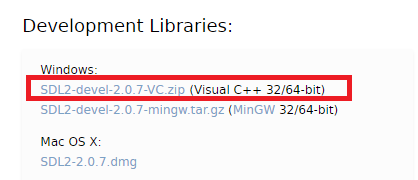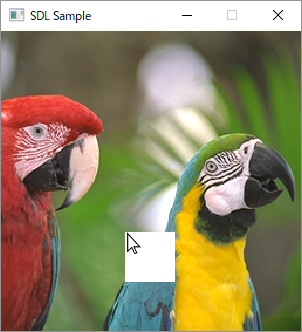Direct2D --- 画像読み込み
Direct2Dにおいて画像ファイルを読み込んで表示する場合、Windows Imaging Component (WIC)を利用します。
今回は実際にそれを実装してみたいと思います。
画像ファイルを32bitRGBAで読み込み
まずIWICImagingFactoryを作成し、factory経由でデコードを行います。
また32bitRGBAに変換するため、IWICFormatConverterを利用します。
#include <wincodec.h> #include <wrl\client.h> using namespace Microsoft::WRL; ComPtr<IWICBitmapSource> WICBitmapFromFile(wchar_t* path) { ComPtr<IWICImagingFactory> factory; AssertHR(CoCreateInstance( CLSID_WICImagingFactory, NULL, CLSCTX_INPROC_SERVER, IID_PPV_ARGS(&factory) )); ComPtr<IWICBitmapDecoder> decoder; AssertHR(factory->CreateDecoderFromFilename( path, NULL, GENERIC_READ, WICDecodeMetadataCacheOnDemand, &decoder )); ComPtr<IWICBitmapFrameDecode> frame; AssertHR(decoder->GetFrame(0, &frame)); // 32bit RGBAに変換 ComPtr<IWICFormatConverter> converter; AssertHR(factory->CreateFormatConverter(&converter)); AssertHR(converter->Initialize( frame.Get(), GUID_WICPixelFormat32bppPBGRA, WICBitmapDitherTypeNone, NULL, 0.0f, WICBitmapPaletteTypeCustom )); return converter; }
Direct2Dアプリケーションで利用
ID2D1RenderTargetのDrawBitmapを利用して描画します。
ComPtr<ID2D1Bitmap> image = WICBitmapFromFile(L"Parrots.bmp"); renderTarget->DrawBitmap(image.Get(), D2D1::RectF(0, 0, width, height));
ただしWICを利用するに際し、アプリケーションの始めにCoInitializeを呼んでおく必要があります。
AssertHR(CoInitialize(NULL));
...
CoUninitialize();
Direct2Dの基本的な使い方は下記を参照してみてください。
Direct2D導入(ID2D1HwndRenderTarget) - 何でもプログラミング
Direct2D導入(ID2D1DeviceContext) - 何でもプログラミング
SDL導入
画像処理コードの確認の際、C++で簡単にウィンドウを表示したいと思い、SDLを少し使ってみました。
SDLダウンロード
下記ページよりdllをダウンロードします。
Simple DirectMedia Layer - SDL version 2.0.7 (stable)

shared_ptrに変換する関数定義(任意)
SDLはCのライブラリのため、ポインタの開放は手動でやる必要があります。(例:SDL_CreateWindow → SDL_DestroyWindow)
ポインタの管理を楽にするため、shared_ptrに変換する関数を準備します。
shared_ptr作成時に対応するデストラクタを渡すようにしています。
#define DEEFINE_TO_SHARED_PTR(type, destructor) std::shared_ptr<type> ToSharedPtr(type* p) { return std::shared_ptr<type>(p, destructor); } DEEFINE_TO_SHARED_PTR(SDL_Window, SDL_DestroyWindow) DEEFINE_TO_SHARED_PTR(SDL_Renderer, SDL_DestroyRenderer) DEEFINE_TO_SHARED_PTR(SDL_Surface, SDL_FreeSurface) DEEFINE_TO_SHARED_PTR(SDL_Texture, SDL_DestroyTexture)
簡単な実装
画像を読み込んで表示するアプリケーションを実装してみます。
ついでにマウスの位置に正方形も描画してみます。

#include <SDL.h> #pragma comment(lib, "SDL2.lib") #pragma comment(lib, "SDL2main.lib") int main(int, char**) { SDL_assert(SDL_Init(SDL_INIT_VIDEO) == 0); std::shared_ptr<SDL_Window> window = ToSharedPtr(SDL_CreateWindow( "SDL Sample", SDL_WINDOWPOS_UNDEFINED, SDL_WINDOWPOS_UNDEFINED, 640, 480, 0 )); SDL_assert(window); std::shared_ptr<SDL_Renderer> renderer = ToSharedPtr(SDL_CreateRenderer(window.get(), -1, 0)); SDL_assert(renderer); std::shared_ptr<SDL_Surface> surface = ToSharedPtr(SDL_LoadBMP("Parrots.bmp")); SDL_assert(surface); std::shared_ptr<SDL_Texture> texture = ToSharedPtr(SDL_CreateTextureFromSurface(renderer.get(), surface.get())); SDL_assert(texture); while (1) { SDL_Event event; if (SDL_PollEvent(&event) == 0) continue; if (event.type == SDL_QUIT) break; else if (event.type == SDL_MOUSEMOTION) { SDL_assert(SDL_RenderClear(renderer.get()) == 0); // 画像描画 SDL_assert(SDL_RenderCopy(renderer.get(), texture.get(), nullptr, nullptr) == 0); // マウスの位置に正方形描画 SDL_Rect rect = { event.motion.x, event.motion.y, 50, 50 }; SDL_assert(SDL_SetRenderDrawColor(renderer.get(), 255, 255, 255, 255) == 0); SDL_assert(SDL_RenderFillRect(renderer.get(), &rect) == 0); SDL_RenderPresent(renderer.get()); } } SDL_Quit(); return 0; }
複数のキーを利用できるConditionalWeakTableクラス
下記記事にて、2つのキーを利用できるWeakTableを実装してみました。
2つのキーを利用できるConditionalWeakTableクラス - 何でもプログラミング
今回は3,4個と拡張しやすいように、複数個のキーを利用できるWeakTableを実装してみたいと思います。
Keysクラス
前回は2つのWeakReferenceプロパティをもっていましたが、今回はWeakReference配列を扱うよう変更しました。
EqualsとGetHashCodeを、WeakReferenceではなくTargetで行うところは変わっていません。
class Keys { public WeakReference[] WeakKeys { get; } int _hash; public bool IsAlive() { return WeakKeys.All(x => x.IsAlive); } public Keys(object[] keys) { WeakKeys = keys.Select(x => new WeakReference(x)).ToArray(); _hash = keys.Aggregate(365011897, (hash, key) => hash * -1521134295 + key.GetHashCode()); } public override bool Equals(object obj) { var keys = obj as Keys; return keys != null && WeakKeys.Length == keys.WeakKeys.Length && WeakKeys.Zip(keys.WeakKeys, TargetEquals).All(x => x); } bool TargetEquals(WeakReference weakRef1, WeakReference weakRef2) { var ref1 = weakRef1.Target; var ref2 = weakRef2.Target; return ref1 != null && ref2 != null && Equals(ref1, ref2); } public override int GetHashCode() { return _hash; } }
WeakTableクラス
まず、一般的はkey配列に対応したクラスを作成します。
class WeakTable<TValue> { object _lockObj = new object(); Dictionary<Keys, TValue> _dictionary = new Dictionary<Keys, TValue>(); public WeakTable() { WeakEventManager<GCNotifier, EventArgs>.AddHandler(null, nameof(GCNotifier.Collected), (s, e) => CheckReferences()); } public void Add(object[] keys, TValue value) { lock (_lockObj) { _dictionary[new Keys(keys)] = value; } } public bool TryGetValue(object[] keys, ref TValue value) { lock (_lockObj) { var key = new Keys(keys); if (_dictionary.ContainsKey(key) == false) return false; value = _dictionary[key]; return true; } } public void CheckReferences() { lock (_lockObj) { _dictionary = _dictionary .Where(x => x.Key.IsAlive()) .ToDictionary(x => x.Key, x => x.Value); } } }
これを利用して、例えば2つのキーのWeakTableは下記のように定義します。
class WeakTable<TKey1, TKey2, TValue> where TKey1 : class where TKey2 : class { WeakTable<TValue> _table = new WeakTable<TValue>(); public void Add(TKey1 key1, TKey2 key2, TValue value) => _table.Add(new object[] { key1, key2 }, value); public bool TryGetValue(TKey1 key1, TKey2 key2, ref TValue value) => _table.TryGetValue(new object[] { key1, key2 }, ref value); }
2つのキーを利用できるConditionalWeakTableクラス
.NETのConditionalWeakTableは、キーを弱参照で保持し、キーがGCされたときに自動でキーと値がRemoveされるようになっています。
しかし、キーとして複数の参照を持ち、参照のうちどれかがGCされたらRemoveを行うといった使い方はできません。
今回は複数の参照キーを指定できるConditionalWeakTableのようなものを実装してみたいと思います。
ConditionalWeakTableの中身
内部的にDependentHandleという構造体で管理しているようですが、privateのため利用できません。
Ephemeronというデータ構造を利用しているらしいですが、詳しくは追及していません。
2つのキーを弱参照で保持するクラス
Keyを弱参照で保持し、EqualsやGetHashCodeをもともとのKeyから算出するクラスを作成します。
class Keys { public WeakReference<TKey1> Key1 { get; } public WeakReference<TKey2> Key2 { get; } int _hash; public bool IsAlive() { return Key1.TryGetTarget(out var key1) && Key2.TryGetTarget(out var key2); } public Keys(TKey1 key1, TKey2 key2) { Key1 = new WeakReference<TKey1>(key1); Key2 = new WeakReference<TKey2>(key2); // WeakReferenceではなく、もとのkeyからhash作成 _hash = 365011897; _hash = _hash * -1521134295 + key1.GetHashCode(); _hash = _hash * -1521134295 + key2.GetHashCode(); } public override bool Equals(object obj) { // WeakReferenceの比較ではなく、中身の参照の比較 var keys = obj as Keys; return keys != null && TargetEquals(Key1, keys.Key1) && TargetEquals(Key2, keys.Key2); } bool TargetEquals<T>(WeakReference<T> weakRef1, WeakReference<T> weakRef2) where T : class { return weakRef1.TryGetTarget(out var ref1) && weakRef2.TryGetTarget(out var ref2) && Equals(ref1, ref2); } public override int GetHashCode() { return _hash; } }
WeakTableクラス
上記のKeysクラスを利用して、WeakTable本体を実装していきます。
class WeakTable<TKey1, TKey2, TValue> where TKey1 : class where TKey2 : class { Dictionary<Keys, TValue> _dictionary = new Dictionary<Keys, TValue>(); public void Add(TKey1 key1, TKey2 key2, TValue value) { _dictionary[new Keys(key1, key2)] = value; } public bool TryGetValue(TKey1 key1, TKey2 key2, ref TValue value) { var key = new Keys(key1, key2); if (_dictionary.ContainsKey(key) == false) return false; value = _dictionary[key]; return true; } public void CheckReferences() { // 不必要なレコードを削除 _dictionary = _dictionary .Where(x => x.Key.IsAlive()) .ToDictionary(x => x.Key, x => x.Value); } }
GCが行われたときにCheckReferencesを呼ぶ
現状のままでは、利用者がCheckReferencesを呼ばないと不必要なレコードが解放されないので、GC時に呼ばれるよう実装してみます。
GCの検知の詳細は下記記事を参照してみてください。
Garbage Collectionを検知する(C#) - 何でもプログラミング
今回はこのようなクラスを用意しました。
class GCNotifier { public static event EventHandler Collected; static GCNotifier() { new DummyObject(); } class DummyObject { ~DummyObject() { if (!AppDomain.CurrentDomain.IsFinalizingForUnload() && !Environment.HasShutdownStarted) { Collected?.Invoke(null, EventArgs.Empty); new DummyObject(); } } } }
GCNotifierを利用して、WeakTableに実装を追加します。
WeakEventManagerでCollectedにアタッチし、lock機構を追加しています。
class WeakTable<TKey1, TKey2, TValue> where TKey1 : class where TKey2 : class { object _lockObj = new object(); Dictionary<Keys, TValue> _dictionary = new Dictionary<Keys, TValue>(); public WeakTable() { WeakEventManager<GCNotifier, EventArgs>.AddHandler(null, nameof(GCNotifier.Collected), (s, e) => CheckReferences()); } public void Add(TKey1 key1, TKey2 key2, TValue value) { lock (_lockObj) { _dictionary[new Keys(key1, key2)] = value; } } public bool TryGetValue(TKey1 key1, TKey2 key2, ref TValue value) { lock (_lockObj) { var key = new Keys(key1, key2); if (_dictionary.ContainsKey(key) == false) return false; value = _dictionary[key]; return true; } } public void CheckReferences() { lock (_lockObj) { _dictionary = _dictionary .Where(x => x.Key.IsAlive()) .ToDictionary(x => x.Key, x => x.Value); } } }
Garbage Collectionを検知する(C#)
通常のプログラミングにおいて、いつGCされたか気にする必要はありませんが、極まれにGCのタイミングで処理をしたい時があります(設計で回避するべきではありますが…)
今回はGCを検知する方法を調べてみました。
GC.WaitForFullGCComplete
GCクラスの関数を利用する方法です。
これを利用するには、App.configで下記が指定されている必要があります。(コンカレントGCを無効化)
<configuration> <runtime> <gcConcurrent enabled="false" /> </runtime> </configuration>
GCNotifierクラスを定義してみます。
GC.RegisterForFullGCNotificationで通知を有効化し、GC.WaitForFullGCApproachとGC.WaitForFullGCCompleteで通知を待ちます。
GC.RegisterForFullGCNotificationの引数は、大きいほど通知を受け取りやすくなるそうです。
static class GCNotifier { public static event Action Collected; public static void Start() { GC.RegisterForFullGCNotification(10, 10); Task.Run(() => { while (true) { GC.WaitForFullGCApproach(); if (GC.WaitForFullGCComplete() == GCNotificationStatus.Succeeded) Collected?.Invoke(); } }); } }
利用は下記のようになります。
GCNotifier.Collected += () => Console.WriteLine("collected");
GCNotifier.Start();
Finalizeを利用
下記のものを簡略化してみます。
Jeffrey Richter: Receiving notifications when garbage collections occur – Microsoft Press blog
DummyクラスのFinalizeでコールバックを呼び、さらに新しいDummyオブジェクトを生成しています。
GCNotifierクラスは下記のようになり、利用方法はGC.WaitForFullGCCompleteの時と同じです。
static class GCNotifier { public static event Action Collected; public static void Start() { new DummyObject(); } class DummyObject { ~DummyObject() { if (!AppDomain.CurrentDomain.IsFinalizingForUnload() && !Environment.HasShutdownStarted) { Collected?.Invoke(); new DummyObject(); } } } }
F#でメモ化(ConditionalWeakTable)
プログラムの高速化のため、一度計算した値を再利用することはしばしばあります。
しかし結果を状態として保存する必要があるため、F#では少し扱いにくいです。
そこで、ある関数を結果を再利用する関数に変換する、memoize関数を定義してみたいと思います。
memoize関数
入力と結果をDictionaryに保存しておく関数に変換しています。
またConditionalWeakTableを利用することにより、selectKeyで寿命を共にするオブジェクトを指定できるようになっています。
let memoize (f : 'Args -> 'Result) (selectKey : 'Args -> 'Key) = let table = ConditionalWeakTable<'Key, Dictionary<'Args, 'Result>>() fun (args : 'Args) -> let key = selectKey args let dictionary = table.GetOrCreateValue(key) if dictionary.ContainsKey(args) = false then dictionary.[args] <- f args dictionary.[args]
利用しやすいように、複数入力に対応した関数を用意しておきます。(寿命は第一引数と同じになります。)
let memoize1 (f : 'Arg -> 'Result) = memoize f id let memoize2 (f : 'Arg1 -> 'Arg2 -> 'Result) = let tupled = memoize (fun (x1, x2) -> f x1 x2) fst fun x1 x2 -> tupled (x1, x2) let memoize3 (f : 'Arg1 -> 'Arg2 -> 'Arg3 -> 'Result) = let tupled = memoize (fun (x1, x2, x3) -> f x1 x2 x3) (fun (x, _, _) -> x) fun x1 x2 x3 -> tupled (x1, x2, x3)
実際の利用
下記のようなNameレコードを例にしてみます。
フルネームを作成するfull関数は、二度目以降は結果を再利用しています。
また計算結果はNameオブジェクトと寿命が同じになります。
type Name = { First : string Last : string } module Name = let full = memoize1 (fun name -> printf "called\n" name.First + name.Last)
let name = { First = "John"; Last = "Smith" } let full = Name.full name // called let full2 = Name.full name
入力に参照型がない場合
今回はConditionalWeakTableを利用したため、寿命を共にする参照型の入力が必要となります。
寿命がなく、入力と結果が共にサイズが小さいのであれば、Dictionaryで管理してもいいと思われます。
ネストしたレコードの更新(Functional lenses)
下記記事にて、リフレクションを用いてネストしたレコードの更新を実装してみました。
ネストしたレコードの更新 (F#) - 何でもプログラミング
今回はFunctional lensesを利用して同様の内容を実装してみたいと思います。
Lens型定義
Lens型は対象オブジェクトから値を取得するGetと、値を更新した新しいオブジェクトを返すSetからなります。
type Lens<'Type, 'Field> = { Get : 'Type -> 'Field Set : 'Field -> 'Type -> 'Type }
Lens関数群定義
Lensを合成するcomposeが最も重要なものとなります。
module Lens = let create get set = { Get = get; Set = set; } let set (lens : Lens<'a, 'b>) (value : 'b) (object : 'a) = lens.Set value object let update (lens : Lens<'a, 'b>) (f : 'b -> 'b) (object : 'a) = lens.Set (lens.Get object |> f) object let compose (lens1 : Lens<'a, 'b>) (lens2 : Lens<'b, 'c>) = { Get = lens1.Get >> lens2.Get Set = lens2.Set >> update lens1 } // composeを楽にする演算子 let inline (>-) (lens1 : Lens<'a, 'b>) (lens2 : Lens<'b, 'c>) = Lens.compose lens1 lens2
実際の利用
下記のレコードが定義されているとします。
type Container = { Value : int } type Child = { Container : Container } type Root = { Child : Child } let record1 = { Child = { Container = { Value = 100 } } }
まずは各レコードのLensを定義します。
module Container = let value = Lens.create (fun x -> x.Value) (fun x y -> { y with Value = x }) module Child = let container = Lens.create (fun x -> x.Container) (fun x y -> { y with Container = x }) module Root = let child = Lens.create (fun x -> x.Child) (fun x y -> { y with Child = x })
レコードの更新は、下記のように記述します。
現在値を参照する場合はLens.updateを利用します。
let record2 = record1 |> Lens.set (Root.child >- Child.container >- Container.value) 200
リフレクションと比較
リフレクションを利用したほうがLensの定義も必要なく簡潔に記述できます。
一方Lensを利用するとパフォーマンスを期待でき、リフレクションのない言語でも応用可能です。